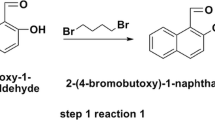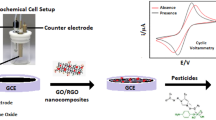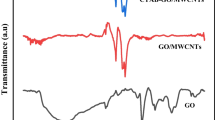Abstract
Methyl parathion (MP), as a typical organophosphorus pesticide, has been widely used in pest control and plant growth regulation. Simultaneously, the problem of pesticide residues also poses a serious threat to the environment and human health. Currently, pesticide residue detection technology still faces great challenges in practical applications due to the problems of expensive facilities and complicated operations in conventional analysis methods. To address these problems, a novel nonenzymatic electrochemical pesticide sensor was reported. A zirconium-based metal organic framework material with terephthalic acid as a ligand (Zr-BDC) was designed to combine with electro-reduced graphene oxides (rGO). The Zr-BDC-rGO nanocomposite contains Zr-OH groups with high affinity for phosphate groups, endowing it with selective recognition and a higher adsorption capacity for MP. Moreover, rGO has a high specific surface area and excellent electron transport capability, making it an excellent functionalized adsorption and substrate material, which could improve the conductivity of the material and achieve a lower detection limit. Upon optimization, this sensor provided a wide linear range from 0.001 to 3.0 μg mL−1 and low limit of detection 0.5 ng mL−1 for MP. This work provides a rapid, sensitive and cost-effective sensing platform for pesticide residue detection.
Graphical abstract








Similar content being viewed by others
References
Liu X, Zhang H, Ma Y, Wu X, Meng L, Guo Y, Yu G, Liu Y (2013) Graphene-coated silica as a highly efficient sorbent for residual organophosphorus pesticides in water. J Mater Chem A 1(5):1875–1884. https://doi.org/10.1039/c2ta00173j
Yang Q, Wang J, Zhang W, Liu F, Yue X, Liu Y, Yang M, Li Z, Wang J (2017) Interface engineering of metal organic framework on graphene oxide with enhanced adsorption capacity for organophosphorus pesticide. Chem Eng J 313:19–26. https://doi.org/10.1016/j.cej.2016.12.041
Zhu Y, Wu J, Han L, Wang X, Li W, Guo H, Wei H (2020) Nanozyme sensor arrays based on heteroatom-doped graphene for detecting pesticides. Anal Chem 92(11):7444–7452. https://doi.org/10.1021/acs.analchem.9b05110
Sassolas A, Prieto-Simón B, Marty J-L (2012) Biosensors for pesticide detection: new trends. Am J Anal Chem 03(03):210–232. https://doi.org/10.4236/ajac.2012.33030
Kim KH, Kabir E, Jahan SA (2016) Exposure to pesticides and the associated human health effects. Sci Total Environ 575:525. https://doi.org/10.1016/j.scitotenv.2016.09.009
Damalas CA, Eleftherohorinos IG (2011) Pesticide exposure, safety issues, and risk assessment indicators. Int J Environ Res Public Health 8(5):1402–1419. https://doi.org/10.3390/ijerph8051402
Xiang H, Cai Q, Li Y, Zhang Z, Cao L, Li K, Yang H (2020) Sensors applied for the detection of pesticides and heavy metals in freshwaters. J Sens 2020:1–22. https://doi.org/10.1155/2020/8503491
Wang J, Pumera M, Chatrathi MP, Escarpa A, Musameh M, Collins G, Mulchandani A, Lin Y, Olsen KJAC (2002) Single-channel microchip for fast screening and detailed identification of nitroaromatic explosives or organophosphate nerve agents. Anal Chem 74(5):1187–1191. https://doi.org/10.1021/ac0111356
Chen L, Dang X, Ai Y, Chen H (2018) Preparation of acryloyl β-cyclodextrin: silica hybrid monolithic column and its application in pipette tip solid, hase extraction and HPLC analysis of methyl parathion and fenthion. J Sep Sci 18:3508–3514. https://doi.org/10.1002/jssc.201701273
Cappiello A, Famiglini G, Palma P, Mangani FJAC (2002) Trace level determination of organophosphorus pesticides in water with the new direct-electron ionization LC/MS interface. Anal Chem 74(14):3547–3554. https://doi.org/10.1021/ac015685f
Reyzer ML, Brodbelt JS (2001) Analysis of fire ant pesticides in water by solid-phase microextraction and gas chromatography/mass spectrometry or high-performance liquid chromatography/mass spectrometry. Anal Chimica Acta 436(1):11–20. https://doi.org/10.1016/S0003-2670(01)00893-5
Shende C, Inscore F, Sengupta A, Stuart J, Farquharson S (2010) Rapid extraction and detection of trace chlorpyrifos-methyl in orange juice by surface-enhanced raman spectroscopy. Sens Instrum Food Qual Saf 4(3–4):101–107. https://doi.org/10.1007/s11694-010-9100-6
Singh AP, Balayan S, Hooda V, Sarin RK, Chauhan N (2020) Nano-interface driven electrochemical sensor for pesticides detection based on the acetylcholinesterase enzyme inhibition. Int J Biol Macromol 164:3943–3952. https://doi.org/10.1016/j.ijbiomac.2020.08.215
Mahmoudi E, Fakhri H, Hajian A, Afkhami A, Bagheri H (2019) High-performance electrochemical enzyme sensor for organophosphate pesticide detection using modified metal-organic framework sensing platforms. Bioelectrochemistry 130:107348. https://doi.org/10.1016/j.bioelechem.2019.107348
Pérez-Fernández B, Martín-Yerga D, Costa-García AJRA (2016) Electrodeposition of nickel nanoflowers on screen-printed electrodes and its application to non-enzymatic determination of sugars. RSC Adv 6:83748–83757. https://doi.org/10.1039/C6RA15578B
Pérez-Fernández B, Martin-Yerga D, Costa-Garcia A (2017) Galvanostatic electrodeposition of copper nanoparticles on screen-printed carbon electrodes and their application for reducing sugars determination. Talanta 175:108–183. https://doi.org/10.1016/j.talanta.2017.07.026
Kardaş F, Beytur M, Akyıldırım O, Yüksek H, Yola ML, Atar N (2017) Electrochemical detection of atrazine in wastewater samples by copper oxide (CuO) nanoparticles ionic liquid modified electrode. J Mol Liq 248:360–363. https://doi.org/10.1016/j.molliq.2017.10.085
Yousefi A, Babaei A, Delavar M (2018) Application of modified screen-printed carbon electrode with MWCNTs-Pt-doped CdS nanocomposite as a sensitive sensor for determination of natamycin in yoghurt drink and cheese. J Electroanal Chem 822:1–9. https://doi.org/10.1016/j.jelechem.2018.05.008
Song Y, Chen J, Sun M, Gong C, Shen Y, Song Y, Wang L (2016) A simple electrochemical biosensor based on AuNPs/MPS/Au electrode sensing layer for monitoring carbamate pesticides in real samples. J Hazard Mater 304:103–109. https://doi.org/10.1016/j.jhazmat.2015.10.058
Rizwan M, Ahmed MU (2019) Electrochemiluminescence study of AuNPs/CdTe-QDs/SWCNTs/chitosan nanocomposite modified carbon nanofiber screen-printed electrode with [Ru(bpy)3]2+/TPrA. Inorg Chem Commun 106:54–60. https://doi.org/10.1016/j.inoche.2019.05.030
Singh M, Tiwari I, Foster CW, Banks CE (2018) Highly sensitive and selective determination of dopamine using screen-printed electrodes modified with nanocomposite of N′-phenyl-p-phenylenediamine/multiwalled carbon nanotubes/nafion. Mater Res Bull 101:253–263. https://doi.org/10.1016/j.materresbull.2018.01.011
Nagles E, García-Beltrán O, Calderón JA (2017) Evaluation of the usefulness of a novel electrochemical sensor in detecting uric acid and dopamine in the presence of ascorbic acid using a screen-printed carbon electrode modified with single walled carbon nanotubes and ionic liquids. Electrochimica Acta 258:512–523. https://doi.org/10.1016/j.electacta.2017.11.093
Salgado-Figueroa P, Gutiérrez C, Squella JA (2015) Carbon nanofiber screen printed electrode joined to a flow injection system for nimodipine sensing. Sens Actuators B Chem 220:456–462. https://doi.org/10.1016/j.snb.2015.05.104
Nellaiappan S, Kumar AS (2017) Electrocatalytic oxidation and flow injection analysis of isoniazid drug using a gold nanoparticles decorated carbon nanofibers-chitosan modified carbon screen printed electrode in neutral pH. J Electroanal Chem 801:171–178. https://doi.org/10.1016/j.jelechem.2017.07.049
Lamas-Ardisana PJ, Fanjul-Bolado P, Costa-García A (2016) Manufacture and evaluation of cup-stacked carbon nanofiber-modified screen printed electrodes as electrochemical tools. J Electroanal Chem 775:129–134. https://doi.org/10.1016/j.jelechem.2016.04.036
Calvo AS, Botas C, Martín-Yerga D, Álvarez P, Menéndez R, Costa-García A (2015) Comparative study of screen-printed electrodes modified with graphene oxides reduced by a constant current. J Electrochem Soc 162(10):B282–B290. https://doi.org/10.1149/2.1021510jes
Li S, Zhang Q, Lu Y, Ji D, Zhang D, Wu J, Chen X, Liu Q (2017) One step electrochemical deposition and reduction of graphene oxide on screen printed electrodes for impedance detection of glucose. Sens Actuators B Chem 244:290–298. https://doi.org/10.1016/j.snb.2016.12.142
Thunkhamrak C, Chuntib P, Ounnunkad K, Banet P, Aubert PH, Saianand G, Gopalan AI, Jakmunee J (2020) Highly sensitive voltammetric immunosensor for the detection of prostate specific antigen based on silver nanoprobe assisted graphene oxide modified screen printed carbon electrode. Talanta 208:120389. https://doi.org/10.1016/j.talanta.2019.120389
Martin-Yerga D, Gonzalez-Garcia MB, Costa-Garcia A (2014) Electrochemical immunosensor for anti-tissue transglutaminase antibodies based on the in situ detection of quantum dots. Talanta 130:598–602. https://doi.org/10.1016/j.talanta.2014.07.010
Mollarasouli F, Serafin V, Campuzano S, Yanez-Sedeno P, Pingarron JM, Asadpour-Zeynali K (2018) Ultrasensitive determination of receptor tyrosine kinase with a label-free electrochemical immunosensor using graphene quantum dots-modified screen-printed electrodes. Anal Chim Acta 1011:28–34. https://doi.org/10.1016/j.aca.2018.01.039
Eguilaz M, Moreno-Guzman M, Campuzano S, Gonzalez-Cortes A, Yanez-Sedeno P, Pingarron JM (2010) An electrochemical immunosensor for testosterone using functionalized magnetic beads and screen-printed carbon electrodes. Biosens Bioelectron 26(2):517–522. https://doi.org/10.1016/j.bios.2010.07.060
Biscay J, García MBG, García AC (2014) Electrochemical biotin determination based on a screen printed carbon electrode array and magnetic beads. Sens Actuators B Chem 205:426–432. https://doi.org/10.1016/j.snb.2014.08.042
Jiang D, Liu Y, Jiang H, Rao S, Fang W, Wu M, Yuan L, Fang W (2018) A novel screen-printed mast cell-based electrochemical sensor for detecting spoilage bacterial quorum signaling molecules (N-acyl-homoserine-lactones) in freshwater fish. Biosens Bioelectron 102:396–402. https://doi.org/10.1016/j.bios.2017.11.040
Wen J, He D, Yu Z, Zhou S (2018) In situ detection of microbial c-type cytochrome based on intrinsic peroxidase-like activity using screen-printed carbon electrode. Biosens Bioelectron 113:52–57. https://doi.org/10.1016/j.bios.2018.04.049
Dreyer DR, Park S, Bielawski CW, Ruoff RS (2010) The chemistry of graphene oxide. Chem Soc Rev 39(1):228–240. https://doi.org/10.1039/b917103g
Zhu Y, Murali S, Cai W, Li X, Suk JW, Potts JR, Ruoff RS (2010) Graphene and graphene oxide: synthesis, properties, and applications. Adv Mater 22(35):3906–3924. https://doi.org/10.1002/adma.201001068
Liu X, Wang F, Aizen R, Yehezkeli O, Willner I (2013) Graphene oxide/nucleic-acid-stabilized silver nanoclusters: functional hybrid materials for optical aptamer sensing and multiplexed analysis of pathogenic DNAs. J Am Chem Soc 135(32):11832–11839. https://doi.org/10.1021/ja403485r
Goncalves G, Marques PAAP, Granadeiro CM, Nogueira HIS, Singh MK, Grácio J (2009) Surface modification of graphene nanosheets with gold nanoparticles: the role of oxygen moieties at graphene surface on gold nucleation and growth. Chem Mater 21(20):4796–4802. https://doi.org/10.1021/cm901052s
Zhang Q, Zhang D, Lu Y, Yao Y, Li S, Liu Q (2015) Graphene oxide-based optical biosensor functionalized with peptides for explosive detection. Biosens Bioelectron 68:494–499. https://doi.org/10.1016/j.bios.2015.01.040
Gao N, He C, Ma M, Cai Z, Zhou Y, Chang G, Wang X, He Y (2019) Electrochemical co-deposition synthesis of Au-ZrO2-graphene nanocomposite for a nonenzymatic methyl parathion sensor. Anal Chim Acta 1072:25–34. https://doi.org/10.1016/j.aca.2019.04.043
Shu H, Chang G, Su J, Cao L, Huang Q, Zhang Y, Xia T, He Y (2015) Single-step electrochemical deposition of high performance Au-graphene nanocomposites for nonenzymatic glucose sensing. Sens Actuators B Chem 220:331–339. https://doi.org/10.1016/j.snb.2015.05.094
Zhang Y, Chang G, Shu H, Oyama M, Liu X, He Y (2014) Synthesis of Pt–Pd bimetallic nanoparticles anchored on graphene for highly active methanol electro-oxidation. J Power Sour 262:279–285. https://doi.org/10.1016/j.jpowsour.2014.03.127
Tran VS, Ngo HH, Guo W, Zhang J, Liang S, Ton-That C, Zhang X (2015) Typical low cost biosorbents for adsorptive removal of specific organic pollutants from water. Bioresour Technol 182:353–363. https://doi.org/10.1016/j.biortech.2015.02.003
Gupta VK, Gupta B, Rastogi A, Agarwal S, Nayak A (2011) Pesticides removal from waste water by activated carbon prepared from waste rubber tire. Water Res 45(13):4047–4055. https://doi.org/10.1016/j.watres.2011.05.016
Yan X, Li H, Hu T, Su X (2017) A novel fluorimetric sensing platform for highly sensitive detection of organophosphorus pesticides by using egg white-encapsulated gold nanoclusters. Biosens Bioelectron 91:232–237. https://doi.org/10.1016/j.bios.2016.11.058
Xu S, Guo C, Li Y, Yu Z, Wei C, Tang Y (2014) Methyl parathion imprinted polymer nanoshell coated on the magnetic nanocore for selective recognition and fast adsorption and separation in soils. J Hazard Mater 264:34–41. https://doi.org/10.1016/j.jhazmat.2013.10.060
Reinsch H, Van der Veen MA, Gil B, Marszalek B, Verbiest T, De Vos D, Stock N (2013) Structures, sorption characteristics, and nonlinear optical properties of a new series of highly stable aluminum MOFs. Chem Mater 25(1):17–26. https://doi.org/10.1021/cm3025445
Li J, Wu YN, Li Z, Zhu M, Li F (2014) Characteristics of arsenate removal from water by metal-organic frameworks (MOFs). Water Sci Technol 70(8):1391–1397. https://doi.org/10.2166/wst.2014.390
Liu L, Zhou Y, Liu S, Xu M (2018) The applications of metal−organic frameworks in electrochemical sensors. Chem Electro Chem 5(1):6–19. https://doi.org/10.1002/celc.201700931
Zhan WW, Kuang Q, Zhou JZ, Kong XJ, Xie ZX, Zheng LS (2013) Semiconductor@metal-organic framework core-shell heterostructures: a case of ZnO@ZIF-8 nanorods with selective photoelectrochemical response. J Am Chem Soc 135(5):1926–1933. https://doi.org/10.1021/ja311085e
Xu Z, Yang L, Xu C (2015) Pt@UiO-66 heterostructures for highly selective detection of hydrogen peroxide with an extended linear range. Anal Chem 87(6):3438–3444. https://doi.org/10.1021/ac5047278
Heck JG, Napp J, Simonato S, Mollmer J, Lange M, Reichardt HM, Staudt R, Alves F, Feldmann C (2015) Multifunctional phosphate-based inorganic-organic hybrid nanoparticles. J Am Chem Soc 137(23):7329–7336. https://doi.org/10.1021/jacs.5b01172
Zhang GY, Zhuang YH, Shan D, Su GF, Cosnier S, Zhang XJ (2016) Zirconium-based porphyrinic metal-organic framework (PCN-222): enhanced photoelectrochemical response and its application for label-free phosphoprotein detection. Anal Chem 88(22):11207–11212. https://doi.org/10.1021/acs.analchem.6b03484
Yan Z, Wang F, Deng P, Wang Y, Cai K, Chen Y, Wang Z, Liu Y (2018) Sensitive electrogenerated chemiluminescence biosensors for protein kinase activity analysis based on bimetallic catalysis signal amplification and recognition of Au and Pt loaded metal-organic frameworks nanocomposites. Biosens Bioelectron 109:132–138. https://doi.org/10.1016/j.bios.2018.03.004
Li L, Chen Q, Niu Z, Zhou X, Yang T, Huang W (2016) Lanthanide metal–organic frameworks assembled from a fluorene-based ligand: selective sensing of Pb2+ and Fe3+ ions. J Mater Chem C 4(9):1900–1905. https://doi.org/10.1039/c5tc04320d
Lian X, Yan B (2016) A lanthanide metal–organic framework (MOF-76) for adsorbing dyes and fluorescence detecting aromatic pollutants. RSC Adv 6(14):11570–11576. https://doi.org/10.1039/c5ra23681a
Wang B, Lv XL, Feng D, Xie LH, Zhang J, Li M, Xie Y, Li JR, Zhou HC (2016) Highly stable Zr(IV)-based metal-organic frameworks for the detection and removal of antibiotics and organic explosives in water. J Am Chem Soc 138(19):6204–6216. https://doi.org/10.1021/jacs.6b01663
Yang Q, Wang J, Chen X, Yang W, Pei H, Hu N, Li Z, Suo Y, Li T, Wang J (2018) The simultaneous detection and removal of organophosphorus pesticides by a novel Zr-MOF based smart adsorbent. J Mater Chem A 6(5):2184–2192. https://doi.org/10.1039/c7ta08399h
Cavka JH, Jakobsen S, Olsbye U, Guillou N, Lamberti C, Bordiga S, Lillerud KP (2008) A new zirconium inorganic building brick forming metal organic frameworks with exceptional stability. J Am Chem Soc 130(42):13850–13851. https://doi.org/10.1021/ja8057953
Jeyapragasam T, Saraswathi R, Chen SM, Lou BS (2013) Detection of methyl parathion at an electrochemically reduced graphene oxide (ERGO) modified electrode. Int J Electrochem Sci 8(11):12353–12366
Katz MJ, Brown ZJ, Colon YJ, Siu PW, Scheidt KA, Snurr RQ, Hupp JT, Farha OK (2013) A facile synthesis of UiO-66, UiO-67 and their derivatives. Chem Commun (Camb) 49(82):9449–9451. https://doi.org/10.1039/c3cc46105j
Moghaddam ZS, Kaykhaii M, Khajeh M, Oveisi AR (2018) Synthesis of UiO-66-OH zirconium metal-organic framework and its application for selective extraction and trace determination of thorium in water samples by spectrophotometry. Spectrochim Acta A Mol Biomol Spectrosc 194:76–82. https://doi.org/10.1016/j.saa.2018.01.010
Hu L, Wu N, Zheng J, Xu J, Zhang M, He P (2014) Preparation of a magnetic metal organic framework composite and its application for the detection of methyl parathion. Anal Sci 30(6):663–668. https://doi.org/10.2116/analsci.30.663
Wang Z, Ma B, Shen C, Cheong LZ (2019) Direct, selective and ultrasensitive electrochemical biosensing of methyl parathion in vegetables using burkholderia cepacia lipase@MOF nanofibers-based biosensor. Talanta 197:356–362. https://doi.org/10.1016/j.talanta.2019.01.052
Ma B, Cheong L-Z, Weng X, Tan C-P, Shen C (2018) Lipase@ZIF-8 nanoparticles-based biosensor for direct and sensitive detection of methyl parathion. Electrochim Acta 283:509–516. https://doi.org/10.1016/j.electacta.2018.06.176
Zhao H, Liu B, Li Y, Li B, Ma H, Komarneni S (2020) One-pot green hydrothermal synthesis of bio-derived nitrogen-doped carbon sheets embedded with zirconia nanoparticles for electrochemical sensing of methyl parathion. Ceram Int 46(12):19713–19722. https://doi.org/10.1016/j.ceramint.2020.04.277
Gong J, Miao X, Wan H, Song D (2012) Facile synthesis of zirconia nanoparticles-decorated graphene hybrid nanosheets for an enzymeless methyl parathion sensor. Sens Actuators B Chem 162(1):341–347. https://doi.org/10.1016/j.snb.2011.12.094
Yue Y, Jiang L, Li Z, Yuan J, Shi H, Feng S (2019) A glassy carbon electrode modified with a monolayer of zirconium(IV) phosphonate for sensing of methyl-parathion by square wave voltammetry. Mikrochim Acta 186(7):433. https://doi.org/10.1007/s00604-019-3493-7
Wang M, Li Z (2008) Nano-composite ZrO2/Au film electrode for voltammetric detection of parathion. Sens Actuators B Chem 133(2):607–612. https://doi.org/10.1016/j.snb.2008.03.023
Yuan J, Jiang L, Tan X, Yue Y, Shi H, Feng S (2020) Fabrication of Zr(IV) modified gold electrode via layer-by-layer self-assembly for methyl parathion. J Electrochem Soc 167(2):027519. https://doi.org/10.1149/1945-7111/ab6979
Acknowledgements
This work was supported by the National Natural Science Foundation of China (Nos. 51672074, 11774082, 11975093), the Natural Science Foundation of Hubei Province, China (No. 2019CFA006) and the Wuhan Application Foundation Frontier Project (No. 201801041011287).
Author information
Authors and Affiliations
Corresponding authors
Ethics declarations
Conflict of interest
The authors declare that they have no conflict of interest.
Additional information
Handling Editor: Andrea de Camargo.
Publisher's Note
Springer Nature remains neutral with regard to jurisdictional claims in published maps and institutional affiliations.
Supplementary Information
Below is the link to the electronic supplementary material.
Rights and permissions
About this article
Cite this article
Gao, N., Tan, R., Cai, Z. et al. A novel electrochemical sensor via Zr-based metal organic framework–graphene for pesticide detection. J Mater Sci 56, 19060–19074 (2021). https://doi.org/10.1007/s10853-021-06436-6
Received:
Accepted:
Published:
Issue Date:
DOI: https://doi.org/10.1007/s10853-021-06436-6




